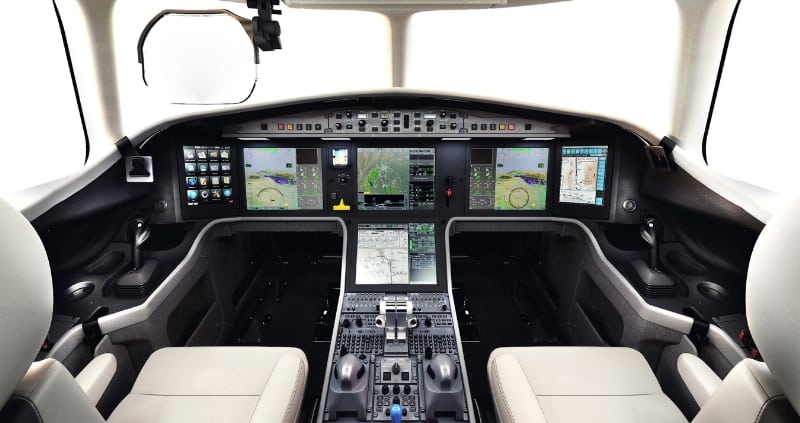[Avionics Today 06-05-2015] Dassault has unveiled its latest iteration of the Falcon jet family: the Falcon 5X, flying with Honeywell’s Primus Epic EASy III cockpit technologies. With the 5X set to make its maiden flight this summer, the suite of integrated avionics aims to offer operators a smooth and easy flying experience through cutting edge technology.
 |
| Cockpit of the Falcon 5X. Photo: Honeywell |
“High end biz jets like these want state-of-the-art functionality, they want more than just the minimum certified capability, so we started offering wide screen, high resolution color displays that could show 3-D type formats that pilots find easier to manipulate, easier to train with, safer to operate,” Tom Lawler, director of marketing and product management at Honeywell, told Avionics Magazine.
Honeywell has provided the Primus Epic avionics suite for the Dassault Falcon jet family since 2003, beginning with the Dassault Falcon 900. As technology continues to evolve, and with future airspace mandates on the horizon the company aims to provide improved situational awareness and flight operational efficiency for high-end business aviation operators.
“We keep finding ways to provide more information with less pilot workload, it offers the curb appeal that aircraft manufacturers want in a $50 million to $60 million aircraft when they bring the customers on board. The customers take a look at the cabin, find what they like about that, and then they take a look at the cockpit and they certainly want to see the compelling features that they know their pilots will use to get them where they want to go, when they want to go, safely and easily,” said Lawler
The new cockpit includes Honeywell’s SmartView Synthetic Vision System (SVS), which provides a 3-D color synthetic image of the outside world when pilot view is obstructed due to weather, pollution, fog or other conditions. It also features a Next Generation Flight Management System (NGFMS), which has been developed to prepare for future navigation and safety requirements and support Required Navigation Performance (RNP) Authorization Required (AR), which will allow a plane to fly a specific path to the runway while avoiding obstacles, such as mountains.
“Everybody has been working on being able to take advantage of RNP-style approaches that are propagating throughout all the various airports that offer both safety and a fuel enhancements. It gets more direct routing into their airports, gets pilots away from their ‘dive-and-drive’ approaches, it will be more of a stable and steady approach path in,” said Lawler.
Other features include: a graphical datalink to allow pilots to manage Air Traffic Control (ATC) communications with a cursor rather than text-based tabbing; the IntuVue RDR-400 weather radar system; and Integrated Navigation (INAV), which merges navigation and sensor data into a single, multilayer display so the pilot can monitor traffic, weather, terrain, and location without switching views.
The EASy III will also include the SmartTraffic TPA-100C Traffic Alert and Collision Avoidance System (TCAS), designed to incorporate Automatic Dependent Surveillance-Broadcast (ADS-B) In on an enhanced display of surrounding air traffic and surface operations.
Lawler also hinted to possible connectivity-related enhancements that aren’t currently committed to the Dassault’s EASy III cockpit, but could be coming.
“We’ve got a broad set of connectivity features and functions we’re working on for avionics. We’re going to avoid the tactical flying part of the mission for now — we don’t want the pilot playing around with Wi-Fi, tablets or too many other things when he or she is hand flying and maybe in a high workload situation — but otherwise we are working connectivity with [Flight Management Systems] FMS, working connectivity with our INAV or map display and ways to bring available weather sources onto the aircraft,” said Lawler, noting that connectivity-enabled weather could be displayed to a pilot through an iPad or could be connected into the avionics systems.
There’s also a possibility that biz jet operators, alongside civil and commercial operators, will eventually be able to transmit weather information to other aircraft through something called connected weather.
“You’ve got thousands of aircraft up in the air all the time and for those who have a Honeywell weather radar, if we could take all the weather information that those aircraft are gathering, broadcast that up into the cloud or out to some centralized location where we can aggregate it, and then send that very fresh weather info out to some other aircraft that’s 100 miles behind, that’s going to be a better weather report than anyone has available today,” said Lawler.
Connectivity may find its way into the maintenance arena as well for aircraft health monitoring as well as managing and transmitting data more efficiently and cheaply. These connectivity-enabled solutions aren’t available yet, however.
“We’re in discussion with Dassault about which connectivity solutions they’d like to bring to their aircraft but they’re not committed on any at this time,” said Lawler.